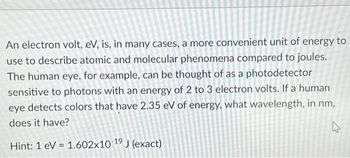
Chemistry
10th Edition
ISBN: 9781305957404
Author: Steven S. Zumdahl, Susan A. Zumdahl, Donald J. DeCoste
Publisher: Cengage Learning
expand_more
expand_more
format_list_bulleted
Concept explainers
Question

Transcribed Image Text:An electron volt, eV, is, in many cases, a more convenient unit of energy to
use to describe atomic and molecular phenomena compared to joules.
The human eye, for example, can be thought of as a photodetector
sensitive to photons with an energy of 2 to 3 electron volts. If a human
eye detects colors that have 2.35 eV of energy, what wavelength, in nm,
does it have?
Hint: 1 eV 1.602x10 19 J (exact)
Expert Solution
This question has been solved!
Explore an expertly crafted, step-by-step solution for a thorough understanding of key concepts.
This is a popular solution
Trending nowThis is a popular solution!
Step by stepSolved in 3 steps with 2 images

Knowledge Booster
Learn more about
Need a deep-dive on the concept behind this application? Look no further. Learn more about this topic, chemistry and related others by exploring similar questions and additional content below.Similar questions
- A ground-state H atom absorbs a photon of wavelength 91.50 nm. What higher energy level did the electron reach?arrow_forwardA laser pulse at 635 nm contains 7.09 mJ of energy. How many photons are in the laser pulse? Use 3 sig figs.arrow_forwardWhat is the frequency of a photon if its wavelength is 2.15 x 104 angstroms? O 1.26 X 1013s-1 O 1.40 X 1014 s-1 O 2.15 X 10-6 s1 O 1.82 X 1019s-1arrow_forward
- The photoelectric work function of a metal is the minimum energy (of a photon) needed to eject a single electron from the surface of the metal by irradiating it with a wavelength of light with that minimum energy. For potassium (K), the work function equals 3.669 x 10 19 J (per photon). a) What is the minimum frequency ( v ) of the photon of light required to eject an electron from the surface of potassium metal? [ Select ] sec- b) What is the wavelength of this photon of light? [ Select ] nm c) What part of the electromagnetic spectrum does this photon of light come from? [ Select ]arrow_forwardA ground state hydrogen atom absorbs a photon of light having a wavelength of 92.05 nm. What is the final state of the hydrogen atom?arrow_forwardA certain microwave oven delivers 750 watts (J/s) of power to a coffee cup containing 66.6 g of water at 37.5°C. If the wavelength of microwaves in the oven is 9.75 cm, how long does it take, and how many photons must be absorbed, to make the water boil? The specific heat capacity of water is 4.18 J/ °C•g and assume only the water absorbs the energy of the microwaves. S photonsarrow_forward
arrow_back_ios
arrow_forward_ios
Recommended textbooks for you
 ChemistryChemistryISBN:9781305957404Author:Steven S. Zumdahl, Susan A. Zumdahl, Donald J. DeCostePublisher:Cengage Learning
ChemistryChemistryISBN:9781305957404Author:Steven S. Zumdahl, Susan A. Zumdahl, Donald J. DeCostePublisher:Cengage Learning ChemistryChemistryISBN:9781259911156Author:Raymond Chang Dr., Jason Overby ProfessorPublisher:McGraw-Hill Education
ChemistryChemistryISBN:9781259911156Author:Raymond Chang Dr., Jason Overby ProfessorPublisher:McGraw-Hill Education Principles of Instrumental AnalysisChemistryISBN:9781305577213Author:Douglas A. Skoog, F. James Holler, Stanley R. CrouchPublisher:Cengage Learning
Principles of Instrumental AnalysisChemistryISBN:9781305577213Author:Douglas A. Skoog, F. James Holler, Stanley R. CrouchPublisher:Cengage Learning Organic ChemistryChemistryISBN:9780078021558Author:Janice Gorzynski Smith Dr.Publisher:McGraw-Hill Education
Organic ChemistryChemistryISBN:9780078021558Author:Janice Gorzynski Smith Dr.Publisher:McGraw-Hill Education Chemistry: Principles and ReactionsChemistryISBN:9781305079373Author:William L. Masterton, Cecile N. HurleyPublisher:Cengage Learning
Chemistry: Principles and ReactionsChemistryISBN:9781305079373Author:William L. Masterton, Cecile N. HurleyPublisher:Cengage Learning Elementary Principles of Chemical Processes, Bind...ChemistryISBN:9781118431221Author:Richard M. Felder, Ronald W. Rousseau, Lisa G. BullardPublisher:WILEY
Elementary Principles of Chemical Processes, Bind...ChemistryISBN:9781118431221Author:Richard M. Felder, Ronald W. Rousseau, Lisa G. BullardPublisher:WILEY

Chemistry
Chemistry
ISBN:9781305957404
Author:Steven S. Zumdahl, Susan A. Zumdahl, Donald J. DeCoste
Publisher:Cengage Learning

Chemistry
Chemistry
ISBN:9781259911156
Author:Raymond Chang Dr., Jason Overby Professor
Publisher:McGraw-Hill Education

Principles of Instrumental Analysis
Chemistry
ISBN:9781305577213
Author:Douglas A. Skoog, F. James Holler, Stanley R. Crouch
Publisher:Cengage Learning

Organic Chemistry
Chemistry
ISBN:9780078021558
Author:Janice Gorzynski Smith Dr.
Publisher:McGraw-Hill Education

Chemistry: Principles and Reactions
Chemistry
ISBN:9781305079373
Author:William L. Masterton, Cecile N. Hurley
Publisher:Cengage Learning

Elementary Principles of Chemical Processes, Bind...
Chemistry
ISBN:9781118431221
Author:Richard M. Felder, Ronald W. Rousseau, Lisa G. Bullard
Publisher:WILEY